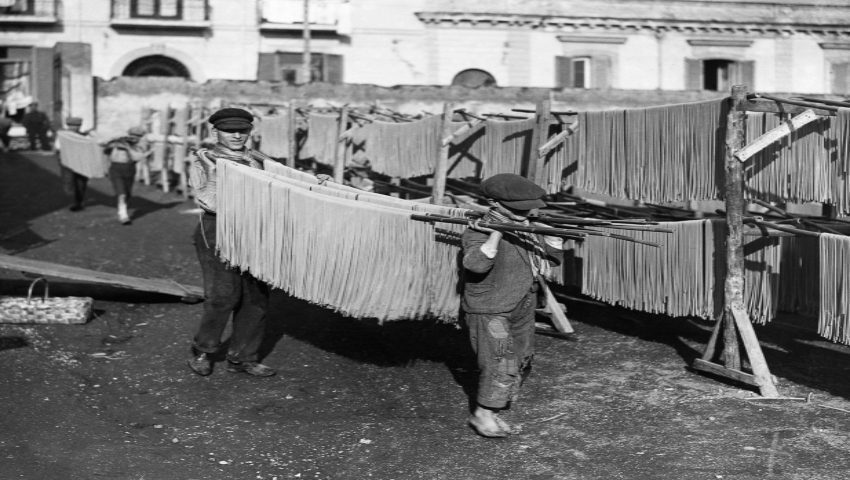How To Order Pasta From Italy: Types, Nutrition and more 2023

Table of Contents
PASTA! Will Italian would ever say no to pasta? Pasta is a staple in the Italian diet, which is why it has become so popular all over the world. But there are so many types of pasta out there, how do you know what type to order? In this blog post, we will discuss everything about How To Order Pasta From Italy- where can you buy Italian pasta online?
Types of pasta in Italy – including which one is right for you and your dietary needs, How to order spaghetti from Italy- nutrition information on each type of pasta.

About Pasta In Italy
In Italy, pasta is a staple food and it’s been around for centuries. In fact, the first time it was made in Italy dates back to the 13th century where they would make fresh dough from durum wheat semolina and water only!
It was not until later that eggs were added into the mix which then evolved into various types of Italian pasta.
The cooking time and thickness of the pasta are different depending on what region you are in, but we will get to that later!
Types of Pasta: Italian Pasta Can Be Broken Down into Two Categories- Fresh and Dried
Fresh vs. dried pasta has been a debate for years now, but there is no right or wrong answer. It really just depends on your tastes and dietary needs!
Fresh pasta: fresh Italian pasta is made with only flour, water and sometimes eggs or other ingredients depending on the type of pasta you are ordering from Italy.
Fresh pasta usually has a shorter cooking time which makes it perfect for dishes that will be served immediately after cooking.
This also means that the pasta will have a very soft texture, so it is perfect for making dishes like lasagna or cannelloni.
Dried Italian pasta: dried Italian pasta has been made with durum wheat semolina and water only since its first inception in the 13th century! This type of pasta requires more cooking time which means the noodles are much more firm.
This texture makes it the perfect pasta to pair with creamier sauces or heavier meat dishes! Also, dried Italian pasta is usually much bigger than fresh pasta which means they are often more filling and therefore better for you if you want a heartier dish in your meal.

Where can I Order Pasta From Italy?
fruugo.it
If you are looking to buy Italian pasta online, fruugo.it is definitely the right place for you! They have a wide variety of types of Italian pasta that are sure to please everyone’s palate!
Fruugo is a leading online marketplace that offers Italian pasta of all types and sizes. They have an extensive selection- over 50 different types of pasta!
Purchase your Italian pasta today for fast delivery to your door.

Iherb.com
iherb.com is another great online marketplace that offers Italian pasta in a variety of types and sizes! They have an assortment of whole wheat, buckwheat or regular spaghetti available for purchase on their website today.
Supermarket Italy
Supermarket Italy is a family-owned business that has been around since 2009. They have become one of the most trusted importers in Europe for high quality Italian and European goods, sourcing them from vendors who care deeply about their product just as much they do!
Idealo.it
idealo.it is another great website for Italian pasta that offers a variety of types and sizes! They have about 30 different varieties to choose from, including white spaghetti made out of whole wheat flour or buckwheat flour.

Eleventwelve.com
If you’re in the market for Italian pasta, Elenventwelve.com is a fantastic place to check out! On their website, they provide a wide range of types, shapes, and sizes.
They have about 20 different Italian pasta types to choose from!
Garofalo
From Gragnano near Naples, Italy, comes the Garofalo pasta brand. Due to its high-quality ingredients, such as rough desert durum wheat and bronze die, Garofalo pasta has a distinct flavour and texture all its own.
In the United Kingdom, fusilli is the most popular short cut pasta made with Garofalo sauce.
Dececco
DeCecco is an Italian company that manufactures dry pasta, flour, and other food goods. It is the world’s third-largest producer of pasta.
In 1908, the company’s trademark was a peasant girl carrying two wheat sheaves. After being devastated by German bombing raids during WWII, the factory was reconstructed.
To accommodate the increasing demand that resulted from the war, De Cecco built a new facility in Pescara in 1950.
In 1980, a new production plant in Fara San Martino was established, increasing the company’s output.
By creating its olive oil brand in 1986, the corporation began to broaden its offers. De Cecco’s product line has now extended to include sauces, cereals, and tomato-based goods.
What are the various types of pasta from Italy?
Italian pasta has a variety of different shapes and sizes.
The long thin spaghetti is considered to be one of Italy’s most popular types of pasta, but that doesn’t mean that it’s for everyone! We will discuss all Italian pasta nutrition information below so you know what type might be right for you.
Here are some popular types of pasta in Italy:
Spaghetti, Linguine, Penne Rigate, Bucatini, Fusilli Lunghi. Acini di Pepe. Farfalle. Orecchiette. Pappardelle and Rigatoni! Are you hungry yet? Let’s get started!
Spaghetti Nutrition Information
Spaghetti can be made out of either white, whole wheat or even buckwheat flour. White spaghetti is the healthiest option since it has a low glycemic index and high protein content.
| Whole-Wheat Spaghetti | Refined/Enriched Spaghetti | |
| Calories | 174 | 220 |
| Protein | 7.5 grams | 8.1 grams |
| Carbs | 37 grams | 43 grams |
| Fiber | 6 grams | 2.5 grams |
| Fat | 0.8 grams | 1.3 grams |
| Manganese | 97% of the RDI | 23% of the RDI |
| Selenium | 52% of the RDI | 53% of the RDI |
| Copper | 12% of the RDI | 7% of the RDI |
| Phosphorus | 12% of the RDI | 8% of the RDI |
| Magnesium | 11% of the RDI | 6% of the RDI |
| Thiamin (B1) | 10% of the RDI | 26% of the RDI |
| Folate (B9) | 2% of the RDI | 26% of the RDI |
| Niacin (B3) | 5% of the RDI | 12% of the RDI |
| Riboflavin (B2) | 4% of the RDI | 11% of the RDI |
| Iron | 8% of the RDI | 10% of the RDI |
source: healthline
Linguine
Linguine, a cousin of Fettuccine, is formed with long, flat strands of pasta that are thinner and narrower. Linguine, which translates as “small tongues” in Italian, originated in the Italian area of Liguria.
The air is fragrant with salty beach breezes and the smells of wonderful meals cooking throughout this neighbourhood.
Penne Rigate
Penne is one of the most well-known Italian pasta shapes, and it is popular both in Italy and around the world. Penne translates to “pen” and takes its name from its shape, which is a short cylinder-shaped pasta with slanted edges.
The design was inspired by the form of a quill. Penne goes well with almost any sauce and is especially good with a thick sauce.
Penne Rigate complements chunky meat, chunky vegetable, cream, or oil-based sauces well. These shapes are also ideal for baking dishes.
Bucatini
Bucatini, which is also known as bucatini spaghetti, is a type of pasta made out of 100% whole Pasta made from durum wheat flour that is shaped into long, narrow tubes is known as bucatini in Italy.
Spaghetti recipes frequently call for it. Pasta is pulled rather than rolled because of the hollow form of the product. For lengthy, hollow strands of pasta, it is necessary to run the dough through a perforated disk. You’ll need a pasta maker and extruder to produce bucatini at home.
Fusilli Lunghi
Fusilli al Buco was created by Neapolitan housewives who wrapped bucatini (the spaghetti with a hole in the centre) over knitting needles to create tight corkscrews of pasta.
Acini di Pepe
Acini di pepe, a very small, circular pasta shape, translates to peppercorns or pepper seeds. It derives from the Latin word acinus, which means “grape stones.”
Though the name of this tiny pasta translates to peppercorns, it is considerably smaller than that.
Acini di pepe is actually the size of a couscous grain! They are a symbol of fertility, which is why they are included in Italian wedding soup, a famous vegetable-based dish.
Farfalle
Because of its shape, farfalle is sometimes known as ‘bow tie pasta.’ This flexible pasta goes well with both light (olive oil, butter) and heavy sauces (cream, tomato, pesto), and it also tastes fantastic in salads.
It can be used as a dressing for a bowl of stir-fried vegetables or meat.






